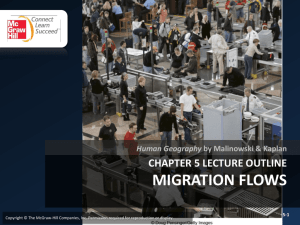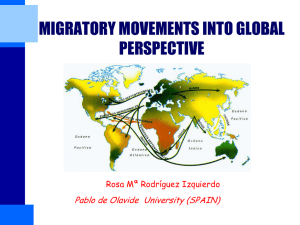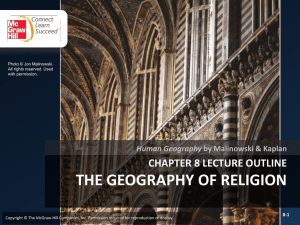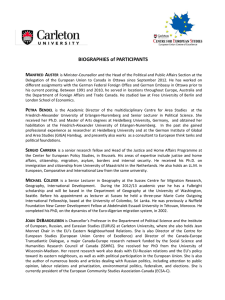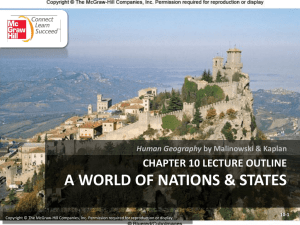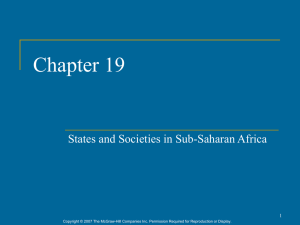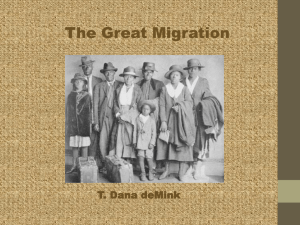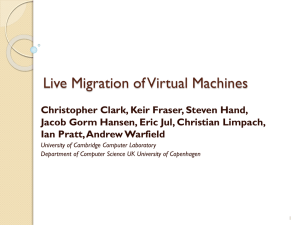CHAPTER 5: MIGRATION FLOWS - Miami Beach Senior High School
advertisement
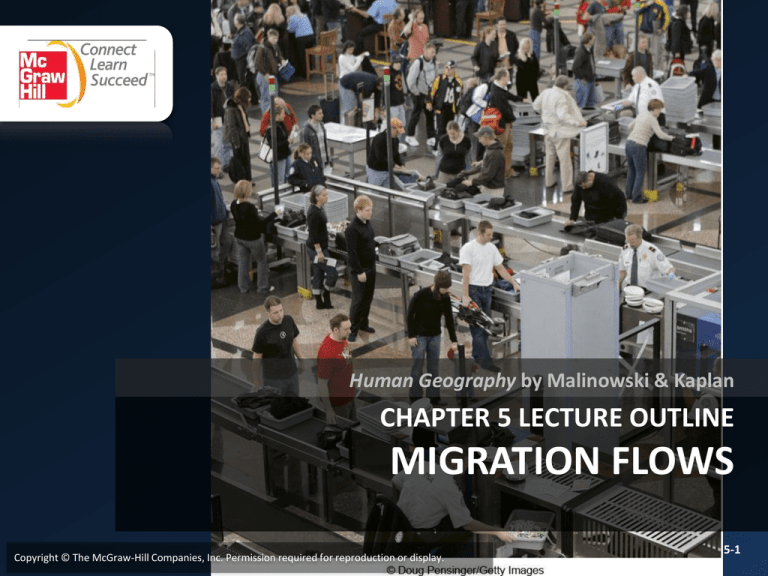
Human Geography by Malinowski & Kaplan CHAPTER 5 LECTURE OUTLINE MIGRATION FLOWS Copyright © The McGraw-Hill Companies, Inc. Permission required for reproduction or display. 5-1 Chapter 5 Modules • • • • • • • 5A Migration versus Movement 5B Types of Migration 5C Human Trafficking 5D Refugees 5E Why Do People Migrate? 5F Consequences of Migration 5G Migration History of the United States Copyright © The McGraw-Hill Companies, Inc. Permission required for reproduction or display. 5-2 5A: Migration versus Movement 1 • Migration • A permanent relocation of one’s place of residence & usually long-distance • Can be international or internal • Cyclical Movement • When people move back & forth between two places or among a few locations Copyright © The McGraw-Hill Companies, Inc. Permission required for reproduction or display. 5-3 5A: Migration versus Movement 2 • Periodic Movement • Similar to cyclical movement but longer in duration • Example: guest workers allowed to work in a country for a limited amount of time Copyright © The McGraw-Hill Companies, Inc. Permission required for reproduction or display. 5-4 5B: Types of Migration 1 • Primitive Migration • Hunter / Gatherers • Mass Migration (aka Group Migration) • Involves a large # of people, such as colonialism • Free Migration • Deciding to migrate without coercion, support, or compulsion • Restricted Migration • Migration today is limited by laws, quotas, etc. Copyright © The McGraw-Hill Companies, Inc. Permission required for reproduction or display. 5-5 5B: Types of Migration 2 • Impelled & Forced Migration • • • • Trail of Tears Japanese-American internment camps Nazi resettlement Slavery • Rural-to-Urban Migration Copyright © The McGraw-Hill Companies, Inc. Permission required for reproduction or display. 5-6 Major World Migrations Copyright © The McGraw-Hill Companies, Inc. Permission required for reproduction or display. Figure 5B.2 5-7 Measuring Migration • Gross Migration • The total # of people that leave & enter a country • Net Migration • The difference between the # of people who leave & the # of people who enter • Out-Migration • The total # of people who leave a country • In-Migration • The total # of people who arrive in a country Copyright © The McGraw-Hill Companies, Inc. Permission required for reproduction or display. 5-8 5C: Human Trafficking • The recruitment, transportation, transfer, harboring or receipt of persons by threat or use of force • 600,000 – 800,000 per year • “People Smuggling” is the shipping of people to circumvent immigration laws • Child Soldiers • ~ 300,000 children Copyright © The McGraw-Hill Companies, Inc. Permission required for reproduction or display. 5-9 People Smuggling Copyright © The McGraw-Hill Companies, Inc. Permission required for reproduction or display. Figure 5C.1 5-10 Child Soldiers Copyright © The McGraw-Hill Companies, Inc. Permission required for reproduction or display. Figure 5C.3 5-11 5D: Refugees • A person living outside of his or her own country who cannot return home because of fear of injury or persecution. • 12 million people worldwide are refugees or seeking asylum • Internally Displaced Persons • A person displaced in his or her own country • About 24 million people worldwide • Repatriation • The process of moving refugees back into their home country Copyright © The McGraw-Hill Companies, Inc. Permission required for reproduction or display. 5-12 5E: Why do People Migrate? 1 • Ravenstein’s Laws 1. More people migrate a short distance than a long distance 2. There is a flow of migrants from remote areas to less remote areas and finally to the cities. • Step Migration 3. Flows of migration also create small counterflows. 4. Long-distance migrants are more likely to be heading to a major city. 5. Urban residents are less likely to migrate than are people who live in the country. 6. Women migrate more than men, but they tend to migrate shorter distances. Ravenstein believed that long-distance migrants were more apt to be men. Copyright © The McGraw-Hill Companies, Inc. Permission required for reproduction or display. 5-13 5E: Why do People Migrate? 2 • Distance Decay • As the distance between two places increases, the volume of interaction between these places decreases • Also known as Zipf’s Law • Gravity Model • Postulates that the interaction between two cities is a function of each city’s population and the distance between them Copyright © The McGraw-Hill Companies, Inc. Permission required for reproduction or display. 5-14 5E: Why do People Migrate? 3 • Push-Pull Model • Everett Lee, 1966 • Intervening obstacles may affect a migrant’s decision Copyright © The McGraw-Hill Companies, Inc. Permission required for reproduction or display. 5-15 5E: Why do People Migrate? 4 • Intervening Opportunities • While migrating from A to B, migrants may become aware of other opportunities • Life Cycle Factors • Migrants move at significant times in their lives • Factor Mobility Model • Argues that migrants move from low- to high-wage areas • Human Capital Model • People move for both economics and for personal reasons Copyright © The McGraw-Hill Companies, Inc. Permission required for reproduction or display. 5-16 5F: Consequences of Migration • Demographic Consequences • Migration can change the size, age composition, and ethnic composition of a population • Economic Consequences • Positive or negative • Do migrants help or hurt a country? • Social Consequences • Can lead to cultural assimilation or cultural conflict Copyright © The McGraw-Hill Companies, Inc. Permission required for reproduction or display. 5-17 5G: Migration History of the U.S. • Colonial Period • 1600 – American Revolution • Mostly Northern Europeans & African Slaves • 1st Wave of European Immigration • 1800 – 1880 • Western & Northern Europeans • 2nd Wave of European Immigration • 1880 – 1921 • Hundreds of thousands per year Copyright © The McGraw-Hill Companies, Inc. Permission required for reproduction or display. 5-18 U.S. Immigration by Year Copyright © The McGraw-Hill Companies, Inc. Permission required for reproduction or display. Figure 5G.1 5-19 U.S. Immigration Region Copyright © The McGraw-Hill Companies, Inc. Permission required for reproduction or display. Figure 5G.4 5-20
